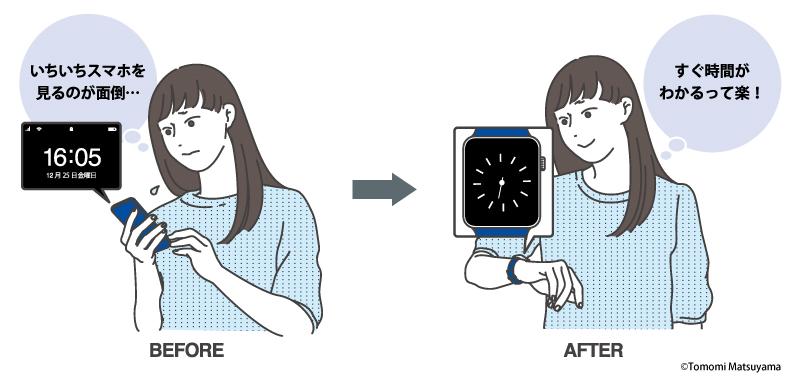Changes in demand for smart watches that have begun to become apparent among young people
It's almost five years since Android Wear and Apple Watch came out in 2014.
Apple Watch compatible with eSIM was released last year, and this year, Android Wear has changed to "Wear OS by Google", and a little new movement is beginning to appear.
Meanwhile, although the degree of attention has dropped compared to the time of 2014, we were able to confirm changes in demand for smart watches among consumers.
Currently, the penetration rate of smart watches is about 4%, which is about half that of AI speakers. The situation is far from 16% (the numerical value of the turning point called the chasm of the diffusion curve theory), which is said to be an index of majority diffusion.
I myself have tried using several smartwatches, but as a result, I stopped using them.
The early days of smartwatches were large in size, and there were issues with design and fit, and the display went to sleep due to power saving, so there was a fatal problem that the time was not known the moment you saw the smartwatch. ..
In a situation where the basic function as a wristwatch is inferior, it needs to be charged every day, and because it is always connected to the smartphone via bluetooth, the battery consumption of the smartphone may increase, so the self-winding mechanical watch can tell the time immediately at any time. Returned to the state. In other words, for those who wear a wristwatch every day, if the basic function of a wristwatch, which is the obvious time to know the time at any time, is no longer satisfied, even if multiple new functions are added, it can be tolerated in daily life. It means that there is no such thing.
Smartwatches have had such problems, but now various problems, including battery problems and clock display problems, have been solved.
In fact, when asked about their intention to use smartwatches, one in four responded that they would like to use it at the moment, which is higher for younger people. In particular, about half of teenage men answered that they would like to use it, and even teenage women have an intention to use it more than 30%.
What I want to pay attention to is the reason for that intention.
When asked why students who want an Apple Watch want an Apple Watch, they answered, "It's convenient because you can see the time without looking at your smartphone."
For those who don't wear watches, it was natural to check the time on a smartphone.
Of course I was aware of this, but I didn't pay attention to it properly.
With larger screens, higher functionality, and richer functions provided by smartphones, the convenience of functions such as "simply check the time" and "view the content of the message" that are used simply and frequently is Not changed.

As with "playing games" and "shopping," it is inevitable that the action of taking out the smartphone from the bag and turning on the screen to "check the time" will become troublesome. be.
Especially for young people who use smartphones frequently and use various functions, they probably want to check the time without having to look at the smartphone.
Of course, that's not the only reason for wanting a smartwatch.
While investigating the actual usage of smartphones, when I checked how people who received a lot of messages were interacting with each other, I found that they made various efforts to process them efficiently.
For example, high school girls can check the message without marking it as read by using 3D touch on the iPhone, so they will be notified by notification and 3D touch whether the content should be replied immediately, and the good ones have already been done. I'm doing a "handling" that I don't read.
It's the same action as a member of society sorting emails into folders and returning unread ones that will be replied later.
Here, the smartwatch is not marked as read, and the content can be grasped to some extent by the notification of the message. In other words, you don't have to check the contents on your smartphone every time you receive a notification.
It is an attractive factor for young people who are highly dependent on smartphones that they do not have to touch the smartphone for time confirmation and message notification.
In other words, it can be said that the smart watch is not only a "mini smartphone" to be worn on the wrist, but also one of the watch options.
Especially for those who don't wear watches habitually, smartwatches are the most sophisticated watches.
The smartwatch that was seen as a gadget has become one of the watches in the smartphone-native generation, so it could spread rapidly depending on the sales method.
From the perspective of living conditions and convenience for young people who are not gadgetters, we are clarifying the needs for smart watches that make sense. It is one of the signs of the post-smartphone era, where the functions that were commonplace on smartphones were seen in the flow of being cut out.
Survey outline
The survey data introduced in the article is based on a voluntary survey by members of the IoT NEWS Living Environment Creation Office.
Survey item
Kentaro YoshidaFuture Business Soken Founder
Worked on probability theory / statistics and internet research at the Department of Mathematics, Faculty of Science, Rikkyo University, and joined NTT Mobile Communication Network (currently NTT DoCoMo) in 1997. He engaged in mobile business consulting after developing applications and products aimed at popularizing non-voice communication.
In 2009 he joined Dentsu Inc. mid-career. He regularly conducts independent surveys to explore trends in the mobile phone industry and engages in industry and consumer insight development work. He is involved in new business development, consulting work, etc., including strategic planning for clients. His book is "Smartphone Marketing" (Nikkei Publishing).
